-
 Bitcoin
Bitcoin $118400
0.47% -
 Ethereum
Ethereum $3836
2.20% -
 XRP
XRP $3.157
2.98% -
 Tether USDt
Tether USDt $0.9999
-0.03% -
 BNB
BNB $801.5
1.31% -
 Solana
Solana $180.9
2.07% -
 USDC
USDC $0.9999
-0.02% -
 Dogecoin
Dogecoin $0.2225
2.50% -
 TRON
TRON $0.3285
-1.02% -
 Cardano
Cardano $0.7789
2.60% -
 Hyperliquid
Hyperliquid $43.60
2.39% -
 Sui
Sui $3.892
4.41% -
 Stellar
Stellar $0.4229
3.34% -
 Chainlink
Chainlink $18.01
3.98% -
 Hedera
Hedera $0.2745
6.77% -
 Bitcoin Cash
Bitcoin Cash $582.3
3.38% -
 Avalanche
Avalanche $23.77
1.04% -
 Ethena USDe
Ethena USDe $1.001
0.01% -
 Toncoin
Toncoin $3.493
3.59% -
 Litecoin
Litecoin $110.0
2.48% -
 UNUS SED LEO
UNUS SED LEO $8.936
-0.37% -
 Shiba Inu
Shiba Inu $0.00001304
2.49% -
 Uniswap
Uniswap $9.999
1.09% -
 Polkadot
Polkadot $3.897
3.26% -
 Monero
Monero $308.6
-0.83% -
 Dai
Dai $0.9999
-0.01% -
 Bitget Token
Bitget Token $4.504
-0.04% -
 Pepe
Pepe $0.00001154
2.95% -
 Cronos
Cronos $0.1471
3.06% -
 Ethena
Ethena $0.6691
19.53%
How to interpret the KDJ K line quickly crossing the D line but the volume is insufficient?
A K line crossing the D line in the KDJ indicator suggests potential momentum shift, but low volume weakens its reliability, increasing risk of false signals.
Jul 30, 2025 at 09:35 am
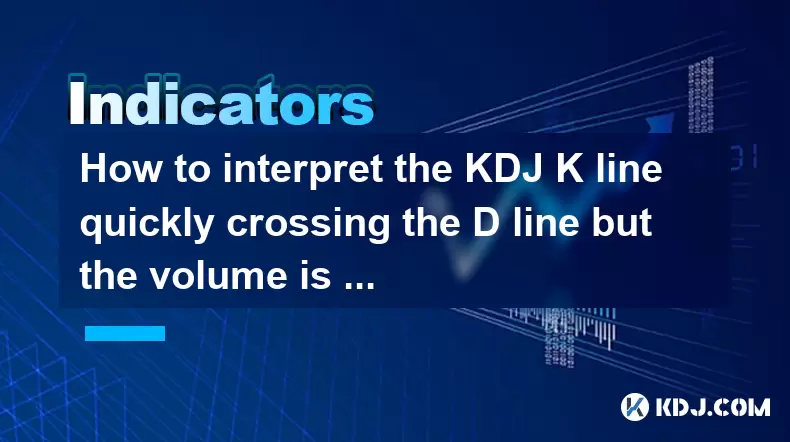
Understanding the KDJ Indicator and Its Components
The KDJ indicator is a momentum oscillator widely used in cryptocurrency trading to identify overbought or oversold conditions. It consists of three lines: the K line, the D line, and the J line. The K line reflects the current price momentum, while the D line acts as a signal line, representing a smoothed version of the K line. The J line measures the distance between the K and D lines, often used to detect extreme conditions. When the K line crosses above the D line, it is typically interpreted as a bullish signal, suggesting upward momentum may be building. Conversely, when the K line crosses below the D line, it signals bearish momentum. However, the reliability of such crossovers depends heavily on accompanying factors, particularly trading volume.
What Does a K Line Crossing the D Line Indicate?
A K line crossing the D line in the KDJ indicator often signals a potential shift in market sentiment. When the K line rises and crosses above the D line, especially from an oversold region (below 20), traders may interpret this as a buy signal. This crossover suggests that short-term momentum is overtaking the medium-term average, possibly indicating the start of a new uptrend. However, the validity of this signal hinges on whether other technical factors support it. In isolation, the crossover can generate false signals, particularly in choppy or low-volume markets. Therefore, traders should not rely solely on the KDJ crossover but must examine additional confirmation signals, with volume being a critical factor.
The Role of Volume in Confirming KDJ Signals
Volume is a key metric in validating any technical signal in cryptocurrency markets. High volume during a K line and D line crossover indicates strong participation from market participants, increasing the likelihood that the price movement is genuine. When volume is insufficient, the crossover may lack conviction. For example, if the K line crosses above the D line but the trading volume remains flat or declines, it suggests limited buying pressure. This could mean the move is driven by a small number of traders or algorithmic noise rather than broad market interest. In such cases, the bullish signal may fail to sustain, leading to a false breakout or reversal. Therefore, low volume undermines the strength of the KDJ signal and increases the risk of entering a losing trade.
How to Analyze Volume in Relation to KDJ Crossovers
To properly assess whether a KDJ crossover is reliable, traders should integrate volume analysis into their decision-making process. This involves several steps:
- Compare current volume to average volume over the past 10 to 20 periods. If the volume during the crossover is significantly below the average, the signal is weak.
- Look for volume spikes coinciding with the crossover. A noticeable increase in volume adds credibility to the signal.
- Check volume trends in the preceding candles. Rising volume before the crossover suggests building momentum, while declining volume suggests weakening interest.
- Use volume indicators such as On-Balance Volume (OBV) or Volume Weighted Average Price (VWAP) to confirm whether buying or selling pressure supports the KDJ signal.
In the context of cryptocurrency, where markets can be highly volatile and manipulated, volume analysis is essential. For instance, a K line crossing the D line on a Bitcoin 4-hour chart with less than 70% of the average volume should be treated with caution. Even if the price moves upward, the lack of volume may indicate a lack of follow-through.
Practical Steps to Respond to Low-Volume KDJ Crossovers
When a K line crosses the D line but volume is insufficient, traders should avoid immediate action and instead follow a structured evaluation process:
- Wait for confirmation from subsequent price action. Observe whether the price continues to rise in the next 1–3 candles with increasing volume.
- Monitor support and resistance levels. If the crossover occurs near a strong resistance zone with low volume, the probability of failure increases.
- Combine with other indicators such as RSI or MACD. If RSI shows divergence or MACD fails to confirm the crossover, the signal is suspect.
- Set conditional entry points. Instead of entering immediately, place a buy order only if volume exceeds a predefined threshold in the next period.
- Use tighter stop-loss orders if entering a position, acknowledging the higher risk due to weak volume.
For example, on a Binance BTC/USDT chart, if the KDJ shows a bullish crossover at 30,000 USDT but the volume bar is less than half the 10-period average, it is prudent to delay entry until volume picks up or price closes above a recent swing high with strong volume.
Common Misinterpretations of KDJ and Volume Signals
Many traders mistakenly assume that any K line crossing the D line is a reliable entry signal, especially in overbought or oversold zones. However, this is a flawed approach when volume is ignored. A common error is entering a long position immediately after a bullish crossover in a sideways market with low volume, expecting a breakout that never materializes. Another mistake is over-relying on the J line without checking volume, leading to premature exits or entries. Additionally, some traders fail to account for timeframe discrepancies—a crossover on a 15-minute chart with low volume may not matter if the 1-hour chart shows declining volume and resistance. Recognizing these pitfalls helps traders avoid false signals and improve their risk management.
Frequently Asked Questions
Can a KDJ crossover be trusted during low trading hours?
Cryptocurrency markets operate 24/7, but volume often drops during off-peak hours, especially in Asian or early European sessions. A K line crossing the D line during these times, even if technically valid, may lack follow-through due to reduced liquidity. It is advisable to wait for volume to increase during major trading sessions before acting.
How do I set volume thresholds for validating KDJ crossovers?
Calculate the average volume over the last 14 periods (a common default). Define a threshold, such as 80% of average volume, below which crossovers are considered weak. Adjust this based on the asset’s typical volatility—high-cap coins like Bitcoin may require stricter thresholds than low-cap altcoins.
Does the KDJ work the same across different timeframes with low volume?
No. On shorter timeframes like 5-minute or 15-minute charts, low volume is more common, and KDJ crossovers occur frequently but with lower reliability. On daily or weekly charts, low volume during a crossover is a stronger red flag, as it suggests a lack of institutional or large-scale participation.
What other indicators pair well with KDJ when volume is low?
The Relative Strength Index (RSI) can help confirm momentum, while Bollinger Bands can indicate volatility contraction. If the KDJ shows a crossover and RSI breaks above 50 with expanding Bollinger Bands, the signal gains strength even if volume is initially low—provided volume follows in subsequent periods.
Disclaimer:info@kdj.com
The information provided is not trading advice. kdj.com does not assume any responsibility for any investments made based on the information provided in this article. Cryptocurrencies are highly volatile and it is highly recommended that you invest with caution after thorough research!
If you believe that the content used on this website infringes your copyright, please contact us immediately (info@kdj.com) and we will delete it promptly.
- Ozak AI: Can This Underdog Crypto Achieve a Bull Run to $1?
- 2025-07-31 22:30:12
- Coinbase Breach: Navigating Insider Risk and Bolstering Security
- 2025-07-31 23:11:55
- Bitcoin Rebounds, WeWake Presale Gains Traction: What's the Buzz?
- 2025-07-31 22:30:12
- Bitcoin, Altcoins, and Volume Watchlists: Decoding the Crypto Landscape
- 2025-07-31 23:11:55
- Tron, Fartcoin, and BlockchainFX: What's Trending (and What's Not) in the Crypto World
- 2025-07-31 21:32:19
- Bitcoin, Corporate Investments, and Sustainability: A New Era or Fleeting Fad?
- 2025-07-31 20:50:14
Related knowledge

How can you use the MACD histogram to determine trend strength?
Jul 31,2025 at 11:10pm
Understanding the MACD Histogram and Its ComponentsThe MACD (Moving Average Convergence Divergence) histogram is a visual representation of the differ...
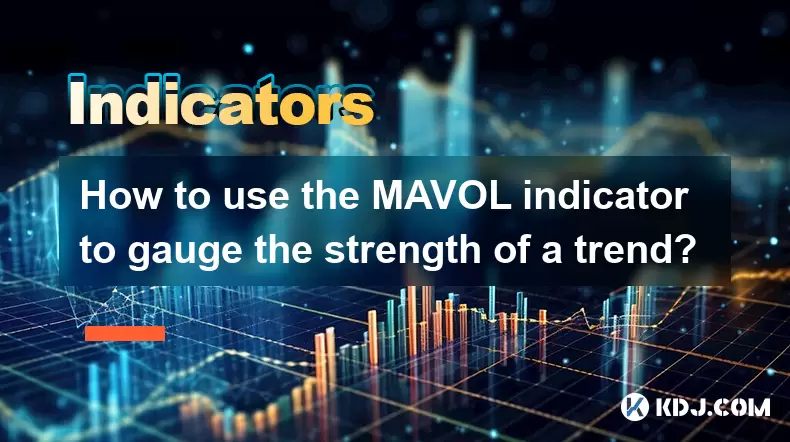
How to use the MAVOL indicator to gauge the strength of a trend?
Jul 31,2025 at 09:57pm
Understanding the MAVOL Indicator in Cryptocurrency TradingThe MAVOL indicator, short for Moving Average of Volume, is a technical analysis tool widel...
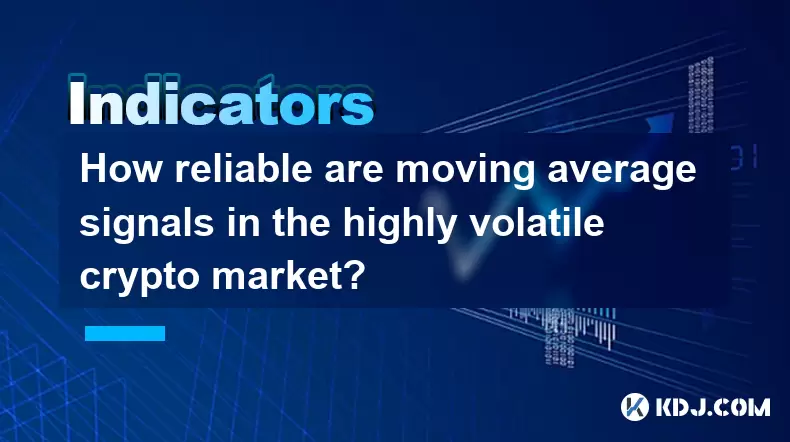
How reliable are moving average signals in the highly volatile crypto market?
Jul 31,2025 at 08:36pm
Understanding Moving Averages in Cryptocurrency TradingMoving averages (MAs) are among the most widely used technical indicators in the cryptocurrency...
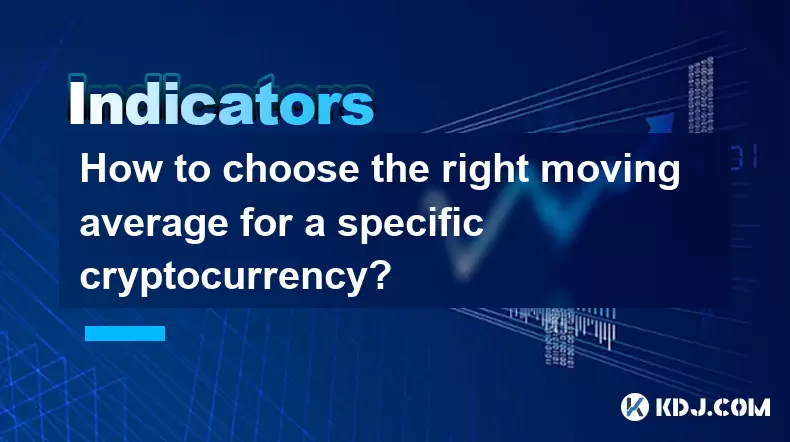
How to choose the right moving average for a specific cryptocurrency?
Jul 31,2025 at 10:29pm
Understanding the Role of Moving Averages in Cryptocurrency TradingMoving averages are foundational tools in technical analysis, widely used by crypto...
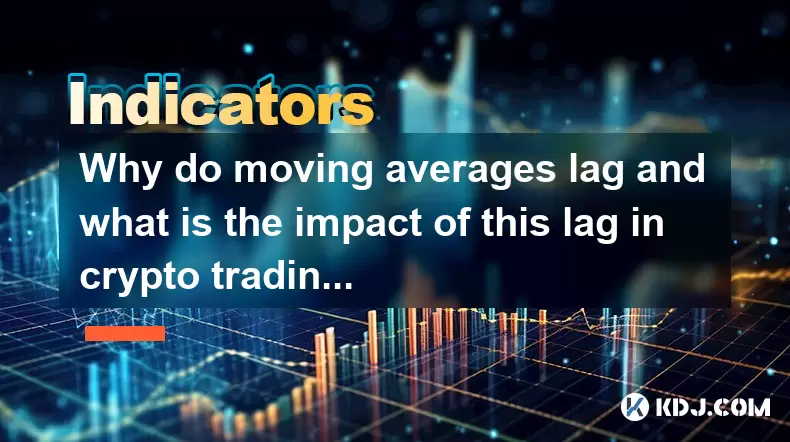
Why do moving averages lag and what is the impact of this lag in crypto trading?
Jul 31,2025 at 08:07pm
Understanding the Concept of Moving Averages in Crypto TradingMoving averages are among the most widely used technical indicators in cryptocurrency tr...
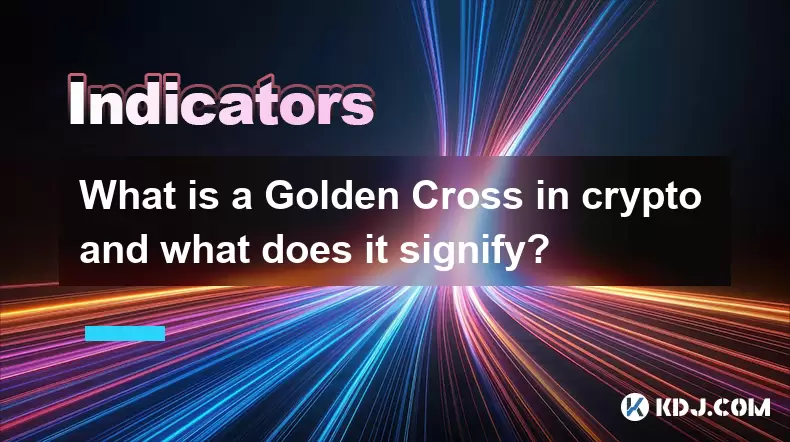
What is a Golden Cross in crypto and what does it signify?
Jul 31,2025 at 10:36pm
Understanding the Golden Cross in Cryptocurrency MarketsThe Golden Cross is a technical analysis pattern widely observed in cryptocurrency trading. It...

How can you use the MACD histogram to determine trend strength?
Jul 31,2025 at 11:10pm
Understanding the MACD Histogram and Its ComponentsThe MACD (Moving Average Convergence Divergence) histogram is a visual representation of the differ...

How to use the MAVOL indicator to gauge the strength of a trend?
Jul 31,2025 at 09:57pm
Understanding the MAVOL Indicator in Cryptocurrency TradingThe MAVOL indicator, short for Moving Average of Volume, is a technical analysis tool widel...

How reliable are moving average signals in the highly volatile crypto market?
Jul 31,2025 at 08:36pm
Understanding Moving Averages in Cryptocurrency TradingMoving averages (MAs) are among the most widely used technical indicators in the cryptocurrency...

How to choose the right moving average for a specific cryptocurrency?
Jul 31,2025 at 10:29pm
Understanding the Role of Moving Averages in Cryptocurrency TradingMoving averages are foundational tools in technical analysis, widely used by crypto...

Why do moving averages lag and what is the impact of this lag in crypto trading?
Jul 31,2025 at 08:07pm
Understanding the Concept of Moving Averages in Crypto TradingMoving averages are among the most widely used technical indicators in cryptocurrency tr...

What is a Golden Cross in crypto and what does it signify?
Jul 31,2025 at 10:36pm
Understanding the Golden Cross in Cryptocurrency MarketsThe Golden Cross is a technical analysis pattern widely observed in cryptocurrency trading. It...
See all articles

























































































